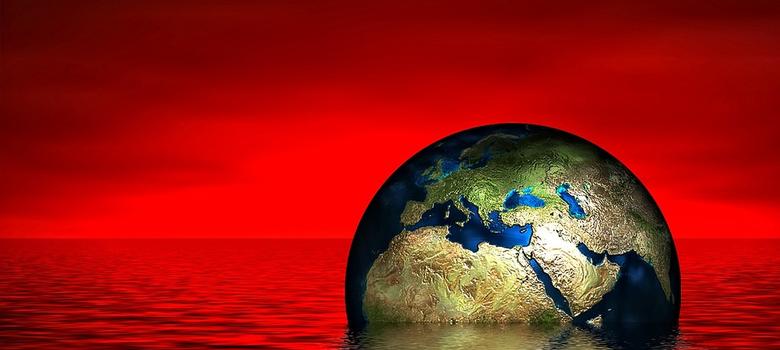
Although 2015 is unusually hot, 1℃ symbolically marks the halfway point to 2℃, widely considered to be the threshold of “dangerous” climate change. In fact, an additional 0.5-1℃ is actually masked by sulphur aerosols which we have added to the atmosphere alongside greenhouse gases.
A temperature level of 1℃ (above pre-industrial levels) is similar to or warmer than the peak temperatures of the early Holocene epoch approximately 8,000-7,200 years ago. Studies of the early Holocene provide clues to what was such a world like.
The climate roller-coaster
The last ice age (or Last Glacial Maximum) peaked around 26,000 years ago. The earth warmed over the coming millennia, driven by an increase in radiation from the sun due to changes in the Earth’s orbit (the Milankovic cycles) amplified by CO₂ released from warming water, which further warmed the atmosphere.
But even as the Earth warmed it was interrupted by cooler periods known as “stadials”. These were caused by melt water from melting ice sheets which cool large regions of the ocean.
Marked climate variability and extreme weather events during the early Holocene retarded development of sustainable agriculture.
Sparse human settlements existed about 12,000-11,000 years ago. The flourishing of human civilisation from about 10,000 years ago, and in particular from 7,000 years ago, critically depended on stabilisation of climate conditions which allowed planting and harvesting of seed and growing of crops, facilitating growth of villages and towns and thereby of civilisation.
Peak warming periods early in the Holocene were associated with prevalence of heavy monsoons and heavy floods, likely reflected by Noah’s ark story.

We can’t measure historical temperatures directly, so scientists use oxygen measurements instead. Human civilisation arose in a period of mostly settled climate. Bruce Railback’s Geoscience Resources
Early civilisations
The climate stabilised about 7,000–5,000 years ago. This allowed the flourishing of civilisations along the Nile, Tigris, Euphrates, Indus and the Yellow River.
The ancient river valley civilisations cultivation depended on flow and ebb cycles, in turn dependent on seasonal rains and melting snows in the mountain sources of the rivers. These formed the conditions for production of excess food.
When such conditions declined due to droughts or floods, civilisations collapsed. Examples include the decline of the Egyptian, Mesopotamian and Indus civilisations about 4,200 years ago due tosevere drought.
Throughout the Holocene, relatively warm periods, such as the Medieval Warm Period (900-1200 AD), and cold periods, such as the Little Ice Age (around 1600 – 1700 AD), led to agricultural crises with consequent hunger, epidemics and wars. A classic account of the consequences of these events is presented in the book Collapse by Jared Diamond.
It’s not just Middle Eastern civilisations. Across the globe and throughout history, the rise and fall of civilisations such as the Maya in Central America, the Tiwanaku in Peru, and the Khmer Empire in Cambodia, have been determined by the ebb and flow of droughts and floods.
Changing the game
Greenhouse gas levels were stable or declined between 8,000-6,000 years ago, but then began to rise slowly. According to William Ruddiman at the University of Virginia, this rise in greenhouse gases was due to deforestation, burning and land clearing by people. This stopped the decline in greenhouse gases and ultimately prevented the next ice age. If so, human-caused climate change began much earlier than we usually think.
Rise and fall in solar radiation continued to shift the climate. The Medieval Warm Period was driven by an increase in solar radiation, while the Little Ice Age was caused at least in part by a decrease.
Now we have changed the game again by releasing over 600 billion tonnes of carbon into the atmosphere since the Industrial Revolution, raising CO₂ concentrations from around 270 parts per million to about 400 parts per million.
One of the consequences of this rise is an extraordinary decline in the North Atlantic Ocean Circulation as cold water from melting of Greenland ice enters the sea. This could potentially lead to a collapse of the Atlantic Meridional Ocean Circulation and a short, regional human-caused cold period, or “stadial”, mostly affecting Europe and North America, similar to those that occurred in the early Holocene.

CO2 concentrations in November 2015. The blue circle shows an area of reduced CO2 corresponding to cooler sea temperatures in the North Atlantic Ocean. NASA, Author provided
While this may sound like “global cooling”, a cold period could have deleterious effects on agriculture and is bound to be succeeded by further warming due to the high atmospheric CO₂ concentrations.
The current shift in state of the atmosphere-ocean-ice system signifies a return to conditions such as existed at the early Holocene, which were less favourable for farming. But it doesn’t stop there.
A further rise in CO₂ and temperature would lead to conditions which existed in the Pliocene before 2.6 million years ago, including many metres of sea level rise (around 10-40 metres), posing an existential threat to the future of civilisation.



